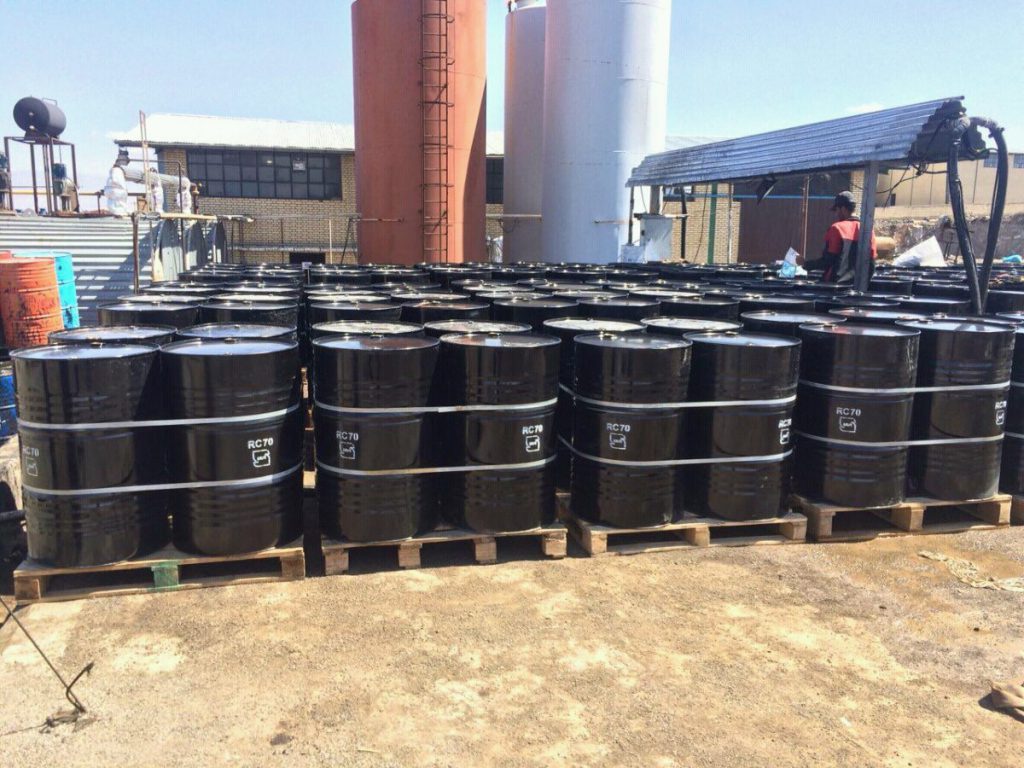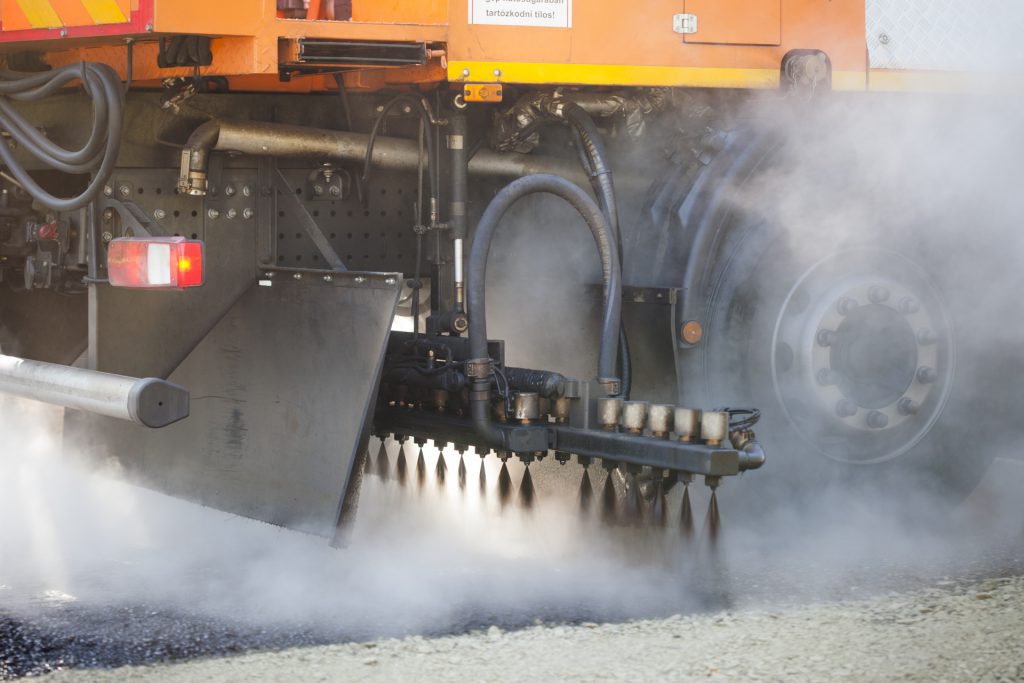Iran Cutback Bitumen

General Description Of Cutback Bitumen
Cutback Bitumen (Liquid Bitumen) is Bitumen that is dissolved in a solvent. Typical solvents include Naptha, gasoline and kerosene, white spirit, etc. The type of solvent controls the curing time while the amount determines the viscosity of the Cutback Bitumen.
The aim is to decrease the viscosity and to increase the penetration of bitumen on the asphalt surface. In comparison with bitumen, cutback bitumen is sprayed on different layers of roads at a notably lower temperature. Once the solvent is evaporated, the remaining bitumen equals penetration bitumen in terms of hardness.
Environmental regulations. Cutback asphalts contain volatile chemicals that evaporate into the atmosphere. Emulsified asphalts evaporate water into the atmosphere.
Loss of high energy products. The petroleum solvents used require higher amounts of energy to manufacture and are expensive compared to the water and emulsifying agents used in emulsified asphalts.
In many places, cutback asphalt use is restricted to patching materials for use in cold weather.
Advantage of Cutback Bitumen
The advantage Cutbacks have over Emulsions is a much higher residual Bitumen percent, typically over 80% compares with over 40-65% for Bitumen emulsions. The result is more Bitumen left on the roadway after curing, for the same volume of binder applied.
Classification of Cutback Asphalt
Cutbacks are divided into two classifications, Rapid-Curing (RC) and Medium-Curing (MC) depending on the solvent used. They are further defined by a number that indicates the minimum kinematic viscosity (fluidity) of the cutback. RC is recommended for surface dressing and patchwork. MC is recommended for premix with less quantity of fine aggregates. SC is used for premix with the appreciable quantity of fine aggregates.
Rapid-curing (RC) cutback asphalt cement is a combination of light diluents with high volatility, typically in the gasoline or naphtha boiling point range, and asphalt cement. Rapid-curing cutback grades include RC-30, RC-70, RC-250, RC-800, and RC-3000.
Rapid Curing Cutback Asphalt shall consist of asphalt cement which has been liquefied by blending with a gasoline type of petroleum solvent. The RC Cutback Asphalt described herein shall be suitable for use FOR ROAD PURPOSES.
Medium curing (MC) cutback asphalts are defined as those asphalt grades, which are prepared by using the medium volatile kerosene as the prime coat with boiling point ranges (MC-30, 70, 250, 800, 3000). The mix is done in a cold manner. Cutback bitumen or asphalt is classified based on the curing as follows, 1) Slow, 2) medium and 3) rapid curing. The degree of evaporation in the medium curing cutback asphalt is intermediate because the kerosene is intermediate volatile liquid as compared to the naphtha and diesel. The degree of liquidity depends on the proportion in which the kerosene is mixed in the asphalt cement.
The following specification for the medium curing cutback asphalt with its properties is as given below. The medium curing cutback asphalt is used in the flexible pavements for surface dressing, prime coating, and tack coating. Evaporation of the solvents will be at a moderate rate. This grade is used with aggregates for ensuring better workability in the mix.
The degree of liquidity developed in each case depends principally on the proportion of solvent to asphalt cement. To less degree, the fluidity of cutback may affect by the hardness of base asphalt. Fluidity result`s degree in several grades of cutback asphalt—some quite fluid at ordinary temperatures and others somewhat more viscous. More viscous grades may require a small amount of heating to make them fluid enough for construction operations.
MC grade designed for mixing with aggregates. Because these grades do not break immediately upon contact with aggregate, mixes using them can remain workable for extended periods of time and lend themselves to cold mix stockpiles. The cutback is said to “cure” as the petroleum solvent evaporates away. The use of cutback asphalts is decreasing because of environmental regulations. Medium curing (MC) asphalt cement uses medium diluents of intermediate volatility generally in the kerosene boiling point range (MC-30, 70, 250, 800, 3000).
low Curing (SC) asphalt cement and oils of low volatility generally in the heavy distillate range (SC-30, SC-70, SC-250, SC-800, and SC-3000). The degree of liquidity developed in each case depends principally on the proportion of solvent to asphalt cement. To a minor degree, the liquidity of the Cutback may be affected by the hardness of the base asphalt from which the Cutback is made. The degree of fluidity results in several Grades of Cutback asphalt—some quite fluid at ordinary temperatures and others somewhat more viscous. The more viscous grades may require a small amount of heating to make them fluid enough for construction operations.
Slow Curing (SC) Cutback asphalts are often called road oils and are used primarily in road-mixing and dust-laying applications. This term originated in earlier days when asphalt residual oil was used to give roads a low-cost, all-weather surface. SC Cutback asphalts are also used for stockpile patching mixes, plant-mixed with graded aggregates and occasionally for priming.
Slow-curing cutback may be achieved from solving bitumen in gasoil or fuel oil or directly from the distillation of crude oil. SC cutbacks do not evaporate under normal weather conditions, but they gradually experience changes in their molecular form. This kind of bitumen is achieved from solving bitumen 85/100 in heavy solvents such as Gasoil or Fuel oil which will not only evaporate but also make it hard.
Slow-curing (SC) cutback asphalt cement combines diluents of low volatility, typically in the heavy distillate range, with asphalt cement.
The degree of fluidity developed in each cutback’s case depends principally on the ratio of solvent to asphalt cement. To a minor degree, the liquidity of the cutback may be affected by the hardness of the base asphalt from which the cutback is made. The degree of fluidity results in several grades of cutback asphalt, some quite fluid at ambient temperatures, and others somewhat more viscous. The more viscous grades may require a small amount of heating to make them fluid enough for construction operations.
Slow-curing (SC) cutback asphalts are often called road oils and are used primarily in road-mixing and dust suppressant applications. This term originated in earlier days when asphalt residual oil was used to give roads a low-cost, all-weather surface. Slow-curing cutback asphalts are also used for stockpile patching mixes, are plant-mixed with graded aggregates, and are used occasionally for priming granular surfaces.
Application of Cutback Asphalt

Cutback bitumens suitable for primer sealing can also be used in the manufacture of pre-mix asphalt, which is used in patch repairs. Cutback bitumens are used extensively in sprayed sealing applications, particularly in cooler weather where they provide improved initial stone retention due to their lower viscosity. Typically, a single application of the appropriate cutback bitumen is sprayed onto the primed pavement onto which aggregate is laid.
Prime and Tack Coating
The process of priming involves applying a low viscosity binder to a prepared but usually unbound aggregate base. It is intended to be absorbed by the top layers of the base and provide a surface more easily ‘wetted’ by a subsequent bituminous covering. The primer will be able to carry traffic for a short time (although this practice is uncommon) and help control dust. Generally, primers are applied at rates between 0.5 and 1.4 L/m2. Cutback bitumens suitable for priming are also used for tack coats, which are applied to an underlying surface to help with the adhesion of subsequent asphalt layer. A typical application rate is between 0.2 and 0.4 L/m2
Prime Sealing
Where temperatures are too cool for an effective priming operation, or where traffic is likely to upset a primed surface before the final seal can be sprayed, a primer seal can be used to give adequate protection of the pavement for periods of up to 6 to 12 months. Cutback bitumens suitable for primer sealing can also be used in the manufacture of pre-mix asphalt, which is used in patch repairs.
Spray Sealing
Cutback bitumens are used extensively in sprayed sealing applications, particularly in cooler weather where they provide improved initial stone retention due to their lower viscosity. Typically, a single application of the appropriate cutback bitumen is sprayed onto the primed pavement onto which aggregate is laid.
RAHA GRUOP supplies and provides transfer of technology for production of all cutback Bitumens in correspondence to ASTM D2026, D2027, D2028, AASHTO M82-75 (2008), AASHTO M92-92 (2008). For any inquiries, please contact our sales team
- Slow Curing Cutbacks (ASTM D2026)
- Medium Curing Cutbacks (ASTM D2027 or AASHTO M82-75 2008)
- Rapid Curing Cutbacks (ASTM D2028 or AASHTO M81-92 2008)
USES OF CUTBACK & EMULSION BITUMEN IN DIFFERENT SYSTEMS OF ROAD MAINTENANCE
| System | Description & Uses | Recomende Product |
| SurfaceDressing | An application of binder on the road surface by a bitumen distributor followed by a covering of aggregates/chippings spread by a hopper gritter. Can be a single or double-layer surface dressing | Cutback: MC -3000 |
| Prime Coating | An application of binder on a granular base to prepare for an asphalt surfacing .Normally a slow setting emulsion or cutback is used for better penetration purposes to seal off the road base. The rate of application can vary from 0.4-1.4 liter/m2 | Cutback : MC-30 MC -70 |
| Tack Coating | A very light application of binder –hand or machine sprayed –to ensure bonding between the existing layer and the new overlay. The rate of application is normally between 0.25-0.7 liter/m2, depending on the surface being sprayed | Emulsion: K1-40 : RS-1K: RS-2K |
| Semi– Grouting /Penetration Macadam | An application of hot binder on a compacted layer of coarse aggregate | Emulsion : RS-3K : MC-3000 Other : Bitumen |
| Slurry Sealing | A maintenance technique where specially tailored emulsion, aggregates, water, and /or mineral filler is mixed in an on-site distributor and spread on an existing road surface at a thickness of 3-6 mm. It is both a preventive and corrective maintenance method for sealing of surface cracks, waterproofing asphalt surfaces and stopping oxidation | Emulsion: ALFA/SS |
| Fog Sealing /Mist Spraying | It is similar to tack coating in that is a very light application of diluted emulsion for renewal/rejuvenation of old asphalt surfaces. The emulsion is usually diluted to a concentration of about 25-30% binder and applied at a rate of 0.3-0.8 liter/m2 | Emulsion : K1-40 : SS-1K : ALFA |
| Dust Binding | A light application of 0.5-2.0 liter/m2 using diluted bitumen emulsion for dust control on unpaved roads | Emulsion: K1-40: SS-1K |

